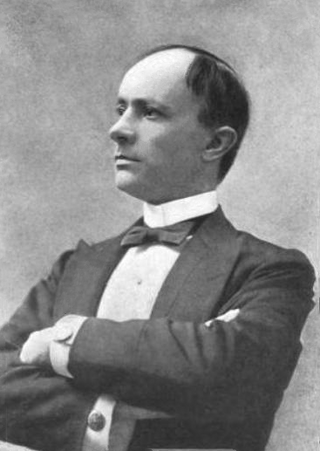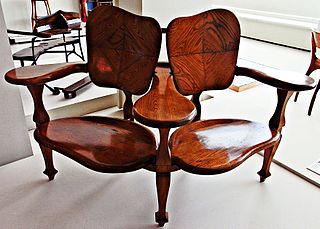
Furniture refers to objects intended to support various human activities such as seating, eating (tables), storing items, working, and sleeping. Furniture is also used to hold objects at a convenient height for work, or to store things. Furniture can be a product of design and can be considered a form of decorative art. In addition to furniture's functional role, it can serve a symbolic or religious purpose. It can be made from a vast multitude of materials, including metal, plastic, and wood. Furniture can be made using a variety of woodworking joints which often reflects the local culture.
Hans Jørgensen Wegner was a Danish furniture designer. His work, along with a concerted effort from several of his manufacturers, contributed to the international popularity of mid-century Danish design. His style is often described as Organic Functionality, a modernist school with emphasis on functionality. This school of thought arose primarily in Scandinavian countries with contributions by Poul Henningsen, Alvar Aalto, and Arne Jacobsen.

Charles Rohlfs, was an American actor, patternmaker, stove designer and furniture maker. Rohlfs is a representative of the Arts and Crafts Movement, and is most famous for his skill as a furniture designer and maker.

Gustav Stickley was an American furniture manufacturer, design leader, publisher, and a leading voice in the American Arts and Crafts movement. Stickley's design philosophy was a major influence on American Craftsman architecture.
Katie Walker is a British furniture designer well known for combining simple components in her work. Her designs combine the function of the object with a sculptural interpretation of its structure. She works with craft and volume manufacturers and produces specific one-off commissions from a variety of materials.

Robin Day, OBE, RDI, FCSD was one of the most significant British furniture designers of the 20th century, enjoying a long career spanning seven decades. An accomplished industrial and interior designer, he was also active in the fields of graphics and exhibitions.
Studio furniture is an American sub-field of studio craft centered on one-of-a-kind or limited production furniture objects designed and built by craftspeople. The work is made in a craftsperson's studio setting as opposed to being made in a high volume factory. This conception of the site of production as being a studio links studio furniture to studio art and reflects its status as an individual creative process. From the earliest furniture of the Arts and Crafts movement to modern-day works of art, studio furniture can be generalized as handmade functional objects that serve as a medium for intellectual and emotional expression and indicate social and cultural concerns of the maker or community. The Furniture Society is an organization devoted to the history and legacy of studio furniture.

Roy McMakin is a San Diego-based artist, designer, furniture maker, and architect.

Thomas J. Duffy is a designer/craftsman whose present work is the conceptualization and creation of curved doors using lasers. Duffy has also crafted one-of-a-kind cabinets, chairs, and other furniture. For many years, Duffy also made St. Lawrence River rowing skiffs. One of his furniture works is in the permanent collection of the Boston Museum of Fine Arts. He has exhibited at numerous galleries and other venues. The New York Times described him as “One of this country’s leading cabinet and chair makers..."

Danish modern is a style of minimalist furniture and housewares from Denmark associated with the Danish design movement. In the 1920s, Kaare Klint embraced the principles of Bauhaus modernism in furniture design, creating clean, pure lines based on an understanding of classical furniture craftsmanship coupled with careful research into materials, proportions, and the requirements of the human body.

Scott Burton was an American sculptor and performance artist best known for his large-scale furniture sculptures in granite and bronze.

Børge Mogensen, was a Danish furniture designer.

The Confidant from Casa Batlló, also known as the Double Sofa or Banc de dues places , is a furniture piece designed by Antoni Gaudí. Originally designed for the dining room of Casa Batlló on Barcelona's Passeig de Gràcia, the chair is currently exhibited in the Modern Art collection of the Museu Nacional d'Art de Catalunya and at Gaudí House Museum in Barcelona. Replicas are displayed at the Gaudí-designed Casa Batlló and Casa Milà.

Furniture created in the Art Nouveau style was prominent from the beginning of the 1890s to the beginning of the First World War in 1914. It characteristically used forms based on nature, such as vines, flowers and water lilies, and featured curving and undulating lines, sometimes known as the whiplash line, both in the form and the decoration. Other common characteristics were asymmetry and polychromy, achieved by inlaying different colored woods.
Rupert Williamson has been a Designer and creator of one-off furniture for over 40 years with work in many museums and public collections, together with his work written about and illustrated in many books and articles.In 1999 he received a PhD for his thesis “New Forms of Imagery in Furniture". The Reflections of a Designer working in the Craft Revival of the 1970s and beyond” together with a major collection of his designs.
Dakota Jackson is an American furniture designer known for his eponymous furniture brand, Dakota Jackson, Inc., his early avant-garde works involving moving parts or hidden compartments, and his collaborations with the Steinway & Sons piano company.
Tim Stead was a British sculptor and furniture maker who worked primarily in wood.
Max Lamb is a British furniture designer who combines traditional, often primitive, design methods with digital design. He is known for employing unusual approaches to using natural materials, including pouring pewter onto sand, and volcanic rock.
Judy Kensley McKie is an American artist, furniture designer, and furniture maker. She has been making her signature style of furniture with carved and embellished animal and plant motifs since 1977. She is based in Boston, Massachusetts.
Annie Evelyn is a furniture designer and artist known for works that combine an innovative use of materials with humor. She is co-founder of Table Fights.











